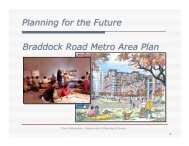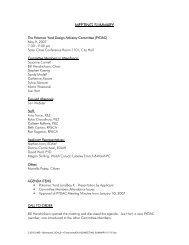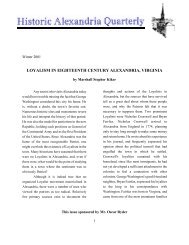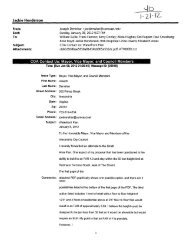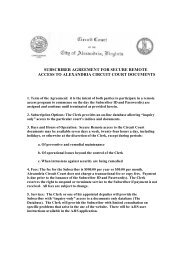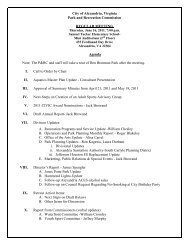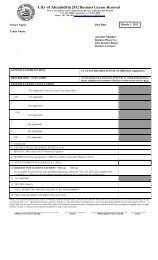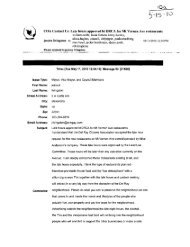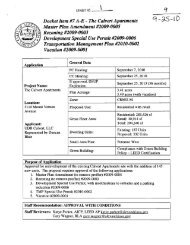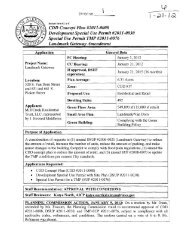Potomac Waterfront Flood Mitigation Study - City of Alexandria
Potomac Waterfront Flood Mitigation Study - City of Alexandria
Potomac Waterfront Flood Mitigation Study - City of Alexandria
You also want an ePaper? Increase the reach of your titles
YUMPU automatically turns print PDFs into web optimized ePapers that Google loves.
Overview <strong>of</strong> <strong>Flood</strong> <strong>Mitigation</strong> Measures<br />
Since floodpro<strong>of</strong>ing actions will be driven by individual property owners, it is not likely that this<br />
measure will be fully implemented. Therefore, in general, floodpro<strong>of</strong>ing is recommended in<br />
conjunction with other flood mitigation measures.<br />
3.1.4 Elevate Structures<br />
The goal in elevating structures is to raise the first finished floor above the 100-year flood<br />
elevation (extreme flood event). Elevating structures can be accomplished in two ways. A home<br />
or business may be elevated by being lifted <strong>of</strong>f its existing foundation, building a new foundation<br />
to an appropriate height, and resetting the home on the new foundation. The second way to<br />
elevate a structure is to raise the floor inside the house while leaving the outside <strong>of</strong> the house in<br />
its original position. This is only an option for structures with relatively high ceilings or where<br />
the elevation required is small. It may also necessitate abandoning a floor that is below the 100<br />
year flood elevation and moving personal property to a higher floor. This is referred to as<br />
“internal elevation.” Internal elevation is described in Section 3.2.2.<br />
The most suitable structures for elevation are one- or two-story wood frame buildings. Data<br />
obtained from the <strong>City</strong> <strong>of</strong> <strong>Alexandria</strong> showed that most structures in the study area are brick or<br />
masonry buildings that are attached to other structures. Furthermore, the entire study area is<br />
within the Old and Historic <strong>Alexandria</strong> District. Also, most <strong>of</strong> the study area is within the<br />
National Register District. The nature <strong>of</strong> this alternative includes an element <strong>of</strong> risk for historic<br />
buildings that may be unacceptable. There is a possibility <strong>of</strong> excessive cracking taking place<br />
when elevating brick and masonry structures. Also, for those structures to be elevated, any<br />
attached buildings would need to be elevated at the same time, which could be a very complex<br />
process. A further complication to this process is the fact that the entire study area is within the<br />
<strong>City</strong>’s Historic District, so any mitigation work would need to comply with historic preservation<br />
guidelines. Therefore, due to the difficulty and complexity <strong>of</strong> elevating row homes and large<br />
masonry buildings, elevation is not recommended as a flood mitigation alternative.<br />
3.1.5 Increase Inlet and Road Elevations<br />
During extreme tide events, Strand Street, within the <strong>Waterfront</strong> Commercial focus area, is<br />
subject to frequent flooding. Storm sewers are typically designed to quickly convey stormwater<br />
away from roadways. However, in instances where extreme tides back up into the municipal<br />
storm sewer, the storm sewers cannot convey the flow from surface run<strong>of</strong>f. If the storm sewers<br />
back up to an elevation equal to the road surface, the water overflows the catchbasin (inlet) and<br />
the roadway floods. This causes traffic safety issues, which generally requires the <strong>City</strong> <strong>of</strong><br />
<strong>Alexandria</strong> <strong>of</strong>ficials to close the roadway. Closed roadways present further safety issues in<br />
limiting access for emergency vehicles. Other access issues include limiting access to residences<br />
and businesses. Note that this occurs at elevations lower than the nuisance flooding elevation <strong>of</strong><br />
4.0 feet as defined by this study. Areas where the inlet rim elevations (elevation <strong>of</strong> the inlet at the<br />
top, where it intersects the road) were less than 4.0 feet were the focus <strong>of</strong> this alternative.<br />
<strong>Flood</strong>ing that occurs more <strong>of</strong>ten than the nuisance flood can sometimes be remedied by raising<br />
the existing road elevation, as well as the associated inlets and manholes along the road. By<br />
increasing the road and inlet rim elevation, the water back-flowing in the storm sewer must reach<br />
a higher elevation to overtop the catchbasin and flood the road. Design constraints that need to<br />
be analyzed are the elevation <strong>of</strong> the sidewalks and first floors <strong>of</strong> the buildings along the roads.<br />
28-JUL-10\\ 3-7




